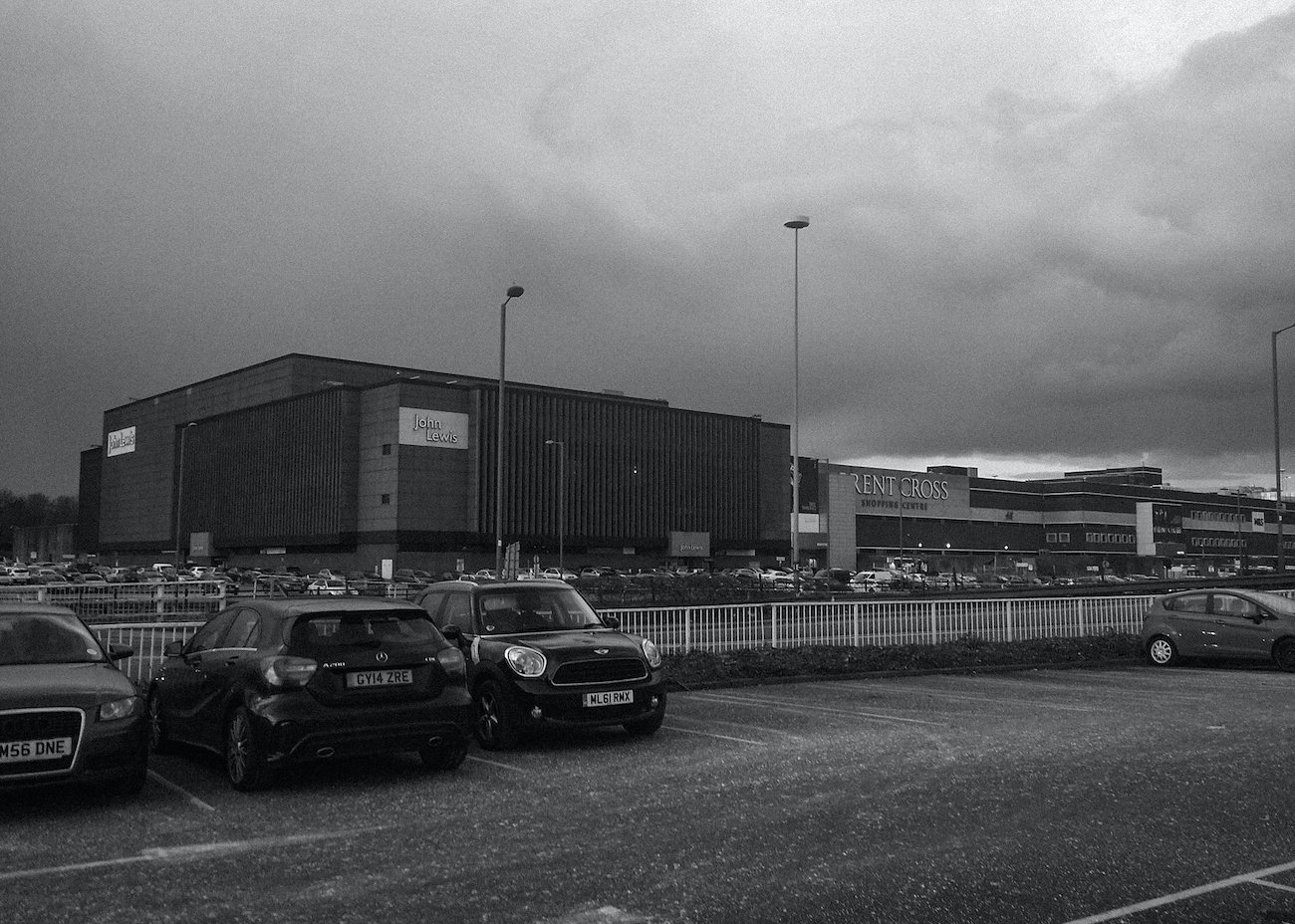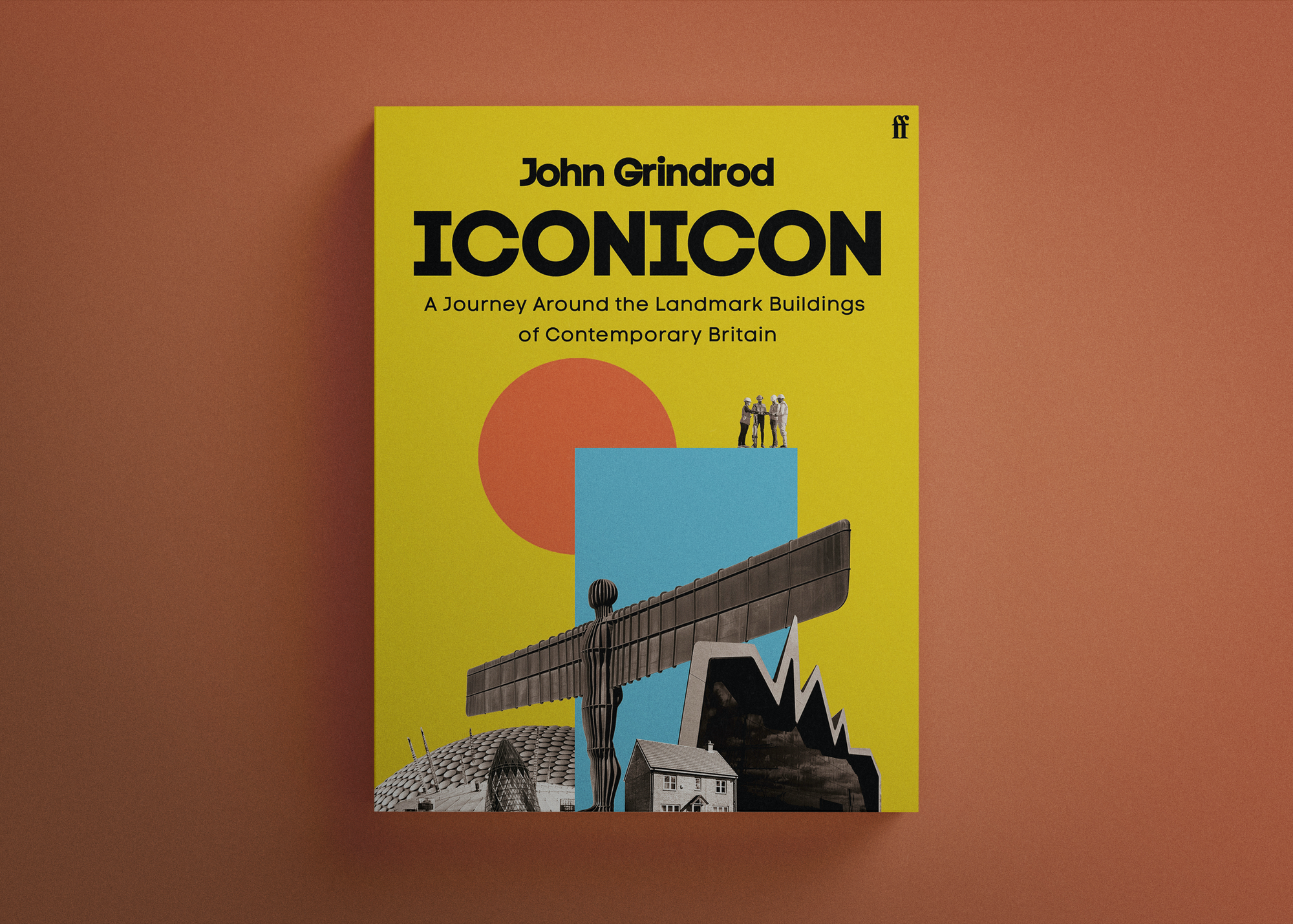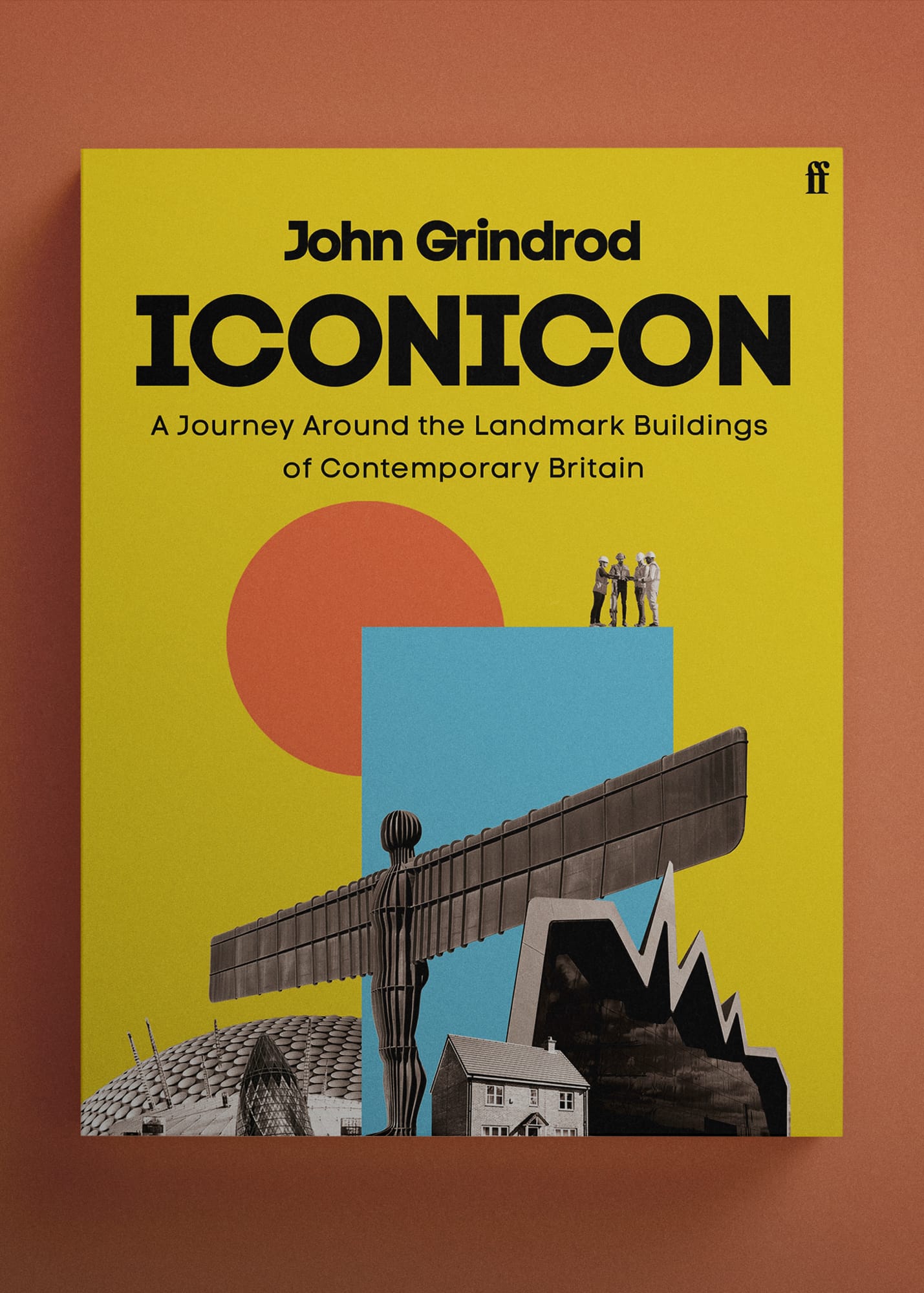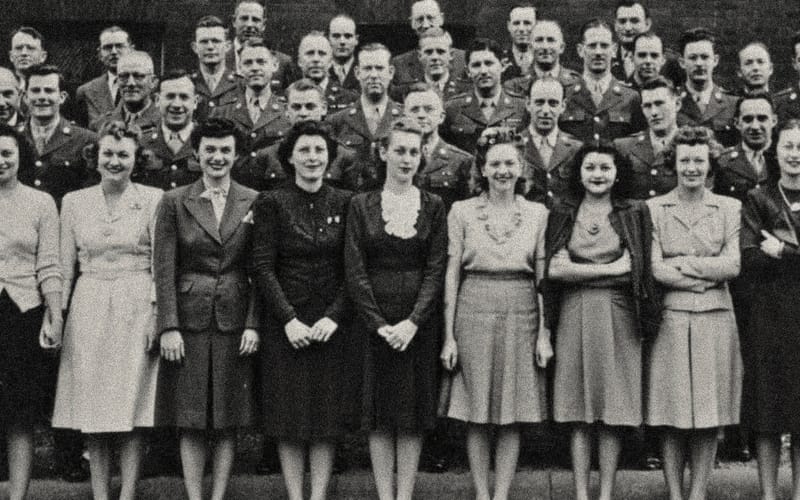Excerpt: The Rise of Tescobethan Sheds
A Journey Around the Landmark Buildings of Contemporary Britain
Wimpey homes. Millennium monuments. Riverside flats. Wind farms. Spectacular skyscrapers. City centre apartments. Out of town malls.
Whether modest or monumental, they offer a living history of Britain, a reminder of the forces that have shaped our modern landscape. Iconicon is an enthralling journey around Britain since 1980, a revelatory architectural grand tour and an endlessly witty and engaging piece of social history.
With an exclusive foreword for Unseen Histories by John Grindrod

The architectural icons of the age, we are told, are the big, shiny things, like the Shard or the Eden Project. But what if the real icons, the ones that tell us who we have really become as a culture, are rather more modest? Barratt homes, say, or business parks. In my research for ⇲ Iconicon I travelled around Britain visiting some of the curious places built since 1980, great or small, and meeting the architects, politicians and residents who have built or lived in them. And so in it I tell the story of Docklands and the Dome, the rebuilding of Gateshead, Manchester and Leeds, the creation of Cardiff Bay and the Scottish Parliament, as well as warehouse flats, eco-homes and the new forms of social housing being built today. It's as much social history as it is about architecture, and much of what I discovered on my travels confounded my expectations.
I am an edgelands child, brought up on the outskirts of Croydon. And so I have a particular fascination with the peripheral places in our towns and cities. The following extract is from a chapter about retail parks and out-of-town malls and business parks, a landscape that barely existed before 1980 and speaks of a modern obsession with ideas of freedom, whether politically or just in dreams of the open road.
— John Grindrod


Out-of-Towners
An abridged excerpt from Iconicon: A Journey Around the Landmark Buildings of Contemporary Britain
The Rise of Tescobethan Sheds
Business parks were not the only out-of-town developments of the time that would change the way our towns functioned and our lives were lived. Following a successful experiment at Brent Cross in North London in the mid-1970s, out-of-town shopping began to emerge as a challenge to our historic town centres. Brent Cross was the first large covered mall away from a town centre, and set a trend followed next in the Midlands at Merry Hill, opened in 1986, built on the site of the old Round Oak steelworks. That same year, an even bigger venture, the MetroCentre in Dunston, Gateshead, opened its doors. The developer, Ashington coal miner’s son John Hall, had been inspired by US malls he’d visited, as well as the success of Brent Cross, though his baby would grow up to be twice that size at a cool 2 million square feet. It started out as some unpromising land he’d bought in the early 1980s, a former tip owned by British Coal, situated between slag heaps and the local power station. It was another of those Geoffrey Howebacked Enterprise Zones, though it took years of schmoozing to persuade imperious ice maidens Marks and Spencer to build their first out-of-town shop here, after which the other chains began to come on board.
When the MetroCentre opened in 1986, it was an impressive half-mile-long structure in dark red brick topped with a series of glass pyramids. Inside were different themed zones in the manner of the Crystal Maze. ‘Today we are seeing fundamental changes in society,’ Hall told The Times in 1987. ‘People are buying different goods from those they used to and they are buying them in a different way. They do it now by motor car and the city centre does not cater for the motor car. There isn’t the space.’ His new shopping monolith would solve these problems and more. ‘The MetroCentre is not just about shopping. It is about how people spend their leisure time. What I have tried to do is bring the outdoors indoors, to create the sort of atmosphere you get in a square in a town in Portugal. If you go into Eldon Square shopping centre [in Newcastle] there is hardly anywhere to sit down. Where here you can sit in the garden, you can stroll, you can have something to eat – I see food as part of leisure – and later this year we will be opening a spectacular entertainment centre for all the family.’

I spoke to James Perry, an architect who grew up in Middlesbrough and remembered his family driving an hour to visit the MetroCentre back in the 1980s. ‘It had fake villages inside in some sort of courtyard. There were lots of people in fancy dress and there was lots of entertainment. I’ve still got quite a haunted memory of the Birdie Song, sat watching from some sort of balcony of all these children doing synchronised dancing. That’s one of my key childhood haunting memories.’ Perry recalled the findings of a study on the MetroCentre by Australian academic Kim Dovey. ‘It’s essentially designed to trap you,’ he explained. ‘It’s almost like this disorientating experience where you have no understanding of where you are, how you got there, how you leave. It was probably intrinsic in the design of the MetroCentre to draw you into different areas and before you know it it’s six o’clock and all the shops are shutting.’ Never one to undersell his achievements, Hall claimed that henceforth ‘city centre retailing will never be the same again’. Within six months of opening, his epic gamble was beginning to pay off. The MetroCentre was pulling in a disproportionate number of affluent ABC1s compared with the surrounding city centres, each spending on average a healthy £44 per visit.
Around London, the new orbital motorway, the M25, was the perfect enabler for a ring of out-of-town shopping centres. By 1986 plans were on the way for Sundon Springs in Bedfordshire, Waterdale Park in Hertfordshire, Lakeside in Essex, Bluewater, Leybourne Grange, Hewitts Park and the Runnymede Centre in Kent, and Elmbridge Mall in Hampshire.
When challenged about the effects of all this out-of-town shopping on town centres, the minister in charge, nicotine-stained Nicholas Ridley, offered a classic faux-humble statement. ‘It is a bigger force than I,’ he said. ‘It is a mistake to say I must stop it or that it can be stopped. Examples from all over the world show that it can’t. It can be accelerated by traffic congestion.’ And besides, he said, if development were proposed on ‘some old sidings on the edge of an industrial town it would be very hard to find any reason against it. It is a good use of land to put a derelict site back into proper use.’ We have ended up with a mere sixteen of these huge covered out-of-town malls, such as the cruise-liner themed Trafford Centre outside Manchester and the ever expanding Cribbs Causeway near Bristol. Instead, most out-of-town shopping in Britain has been at a rather more humble end of the spectrum: retail parks.
.jpg)
The retail park of my youth was Purley Way in Croydon, sprawling over the site of the old Croydon airport, power station and factory units, a place where products including Tizer had once been manufactured. Industry had grown up beside the A23 trunk road, which had opened in 1925, but by the eighties the airport and power station were long gone. Instead, my folks used to cruise on down to Queensway Furniture Store, the first of the big new retail sheds, which opened there in 1980. The bendy white laminated chipboard furniture in my bedroom came from MFI, the flatpack furniture giant who arrived in 1981. All the big box retailers moved in over time: Payless DIY in 1983, Do It All in 1986, and Ikea on the old power station site in 1992. Purley Way was a place where retailers piloted their stores too: the first Sainsbury’s Homebase in 1981, the first PC World in 1991. What a crucible. Because central Croydon had such a vast and dramatic concrete shopping centre, I remember being confused by my parents’ obsession with these scrappy sheds sitting awkwardly by an urban motorway. In contrast to this semiderelict post-industrial land, the futuristic 1970s town centre felt like a place, even if that place was the overcrowded metropolis of a dystopian futuristic world glimpsed on some low-budget teatime TV sci-fi. The fibreglass sheds of Purley Way, with their endless surface car parking, felt barely a place at all, a scribble in the margins, the superstores giving off an air of abandonment before they even opened. They were the enablers of a kind of super-sized consumerism, DIY kits to build DIY stores, flatpack shops for flatpack furniture, industrial sized premises for industrial sized products. This wasn’t no-frills, it was actively anti-frills. Forklift trucks and wooden pallets, massive packs in massive stacks, barrows instead of baskets. It was in some ways a throwback to the pre supermarket days of pick-your own, where a trip out of town might be to a local farm to gather punnets of strawberries or rummage through outbuildings and perhaps fall on a rusty nail.
Some retailers had been championing this kind of shedbased shopping experience for decades. The first out-of-town supermarket in Britain opened in 1964 in the small village of West Bridgford outside Nottingham. It was started up by GEM, an American operator, who essentially ran it as a series of franchised stores within. It didn’t catch on, and the shop was failing before a Leeds-based company founded by Associated Dairies and Asquith the butchers took it over, renamed it Asda and turned its fortunes around with an emphasis on discounting and patting their back pockets.
.jpg)
One rather more notorious out-of-town retailer began in the early 1960s near Liskeard in Cornwall, and has slowly grown into a small chain of department stores in the south-west. Trago Mills was founded by Mike Robertson, and was transformed from its small shed-style beginnings when in 1978 he hired Cornish architect Charles Hunt to redesign the sites. You might claim the results are postmodern, but instead they feel like the sort of thing a re-enactment society with an unexpectedly massive legacy might want to throw up for rough ’n’ tumble role play.
I visited Trago’s Liskeard branch in 2018 with my partner’s family. We drove in off the main road and dodged the rare breed chickens running loose in the car park. There in the leafy countryside sits a mock Bavarian-style castle, Lilliput Lane scaled up to human size. There is half-timbering and rough plasterwork, turrets, witch’s-hat outbuildings, and gargoyles, one of which is an alien. It sounds fun; it wasn’t. Through the automatic doors, you are confronted with the crushing reality – the interior is an endlessly drab hotchpotch of Portakabin-style oblongs plonked together as if to maximise the number of awkward changes of level and randomly constructed walls. The selection of products on offer remind me of Alexei Sayle saying if the Walkman had been invented in Britain it would have come in a massive teak box with the headphones from a Lancaster bomber. Trago Mills is not so much out of town as out of time; the dark ages, to be precise. The walls are plastered with countless gloating notices about shoplifting, written in a tone somewhere between Lord Haw-Haw and a particularly worrying s/m contact ad. This fantasia, it seems to be saying, is an island outside of the law, where only its own hang ’em and flog ’em rules apply. For all of the suggestions that when you enter Trago Mills you are encountering the real Britain stifled for so long under EU rules, a place with a respect for our great history, the building instead reveals a worrying thought that real history is a cheap trick.
In the eighties, Mike Robertson placed ads in the local press calling for gay men to be castrated, and his son, Bruce, has continued the tradition, with Muslim-baiting ads and endless propaganda for Brexit in store and advertising. Service has been replaced by security. The cash desks feel more like a Cold War checkpoint. Receipts are checked on the way out. It’s a fantasy railing against perceived inequalities, a haven of white heterosexual Anglo-Saxon dominance because we don’t have many of those. While we were there, we got stuck in a lift for ages. It was the only good bit.
.jpg)
A challenge for food retailers in the late sixties was that only 47 per cent of people in Britain had fridges, and deep freezers were a rarity. Even so, there were thirty-three Asdas in the north by 1970, the year Tesco announced they would follow their lead out of town. So successful was this strategy that in 1984 their deputy chair, Ian MacLaurin, announced: ‘I cannot see Tesco ever again developing a shop in the high street.’ Supermarket chains started to expand into out-of-town sites, and each developed a unique look. In classic sitcom Never the Twain style, competitive neighbours Tesco and Sainsbury adopted opposing philosophies with gusto, be it one size-swamps-all hokey pitched-roof barn-style Tescobethan or super-modern Sainsbury pretending new stores were bespoke High Tech installations derived from Norman Foster’s Sainsbury Centre art gallery. Over-varnished craft centres turned out to be Morrisons and knock-off Palladian villas Safeway. Asda, who had formulated the big box supermarket before anyone else, stuck with anonymous fibreglass airships and blank red-brick facades, a style best described as Asdustrial. In 1987, after all of this rush to the outskirts that they’d helped create, Tesco commissioned a report into the state of the high streets they had abandoned. US-style out-of-town retail parks were changing Britain, they gasped. ‘Such developments could well lead to a serious rundown of the traditional high streets, many of which are already in a precarious state,’ wrote the report’s author Dr Ross Davies, director of the Oxford Institute of Retail Management and the useful idiot of the day.
The big boxes continued to multiply, with the amount of large retail warehouses of the likes of Toys “R” Us and PC World rising across the UK from barely any in 1985 to nearly 6 million square feet in 1988. Yet, as if to prove that nothing stayed the same, in June 1992 the first of a new breed of urban micro supermarkets opened. Tesco Metro arrived in Covent Garden, precipitating a rush for supermarket chains to colonise once more the inner cities they had so recently abandoned. There was also a rearguard defence action being fought against their European competitors Netto, Aldi and Lidl. Major-era environment minister John Selwyn Gummer worked with Asda, Sainsbury’s and Tesco on an extraordinary law that would make it much harder to build new out-of-town supermarkets. The drawbridge was being pulled up. It wasn’t only space these big chains colonised, but time as well. Christmas 1990 saw a number of supermarkets and DIY stores flouting the Sunday trading ban and opening to the public, with little consequence other than profit. The same happened the following two Christmases, until Sunday trading was legalised in 1993. Whatever the big supermarkets wanted, they got.
.jpg)
It was visiting this kind of 1990s out-of-town infrastructure that helped sustain me through the UK’s first coronavirus lockdown in the spring of 2020. I spent those months in Milton Keynes at my partner’s house. We took our daily exercise walk through a nearby business park to a network of lakes designed to balance the city’s water table. Late afternoon visits revealed rabbits and heron and mistle thrush and moorhen living a rustle and hop away from pomo sheds, home to Interpower, SAI Global, Envisics, Riskex – modern businesses that might do just anything. This was not on the outskirts, mind, it was near the centre of this new town, whose Los Angeles aspirations meant edgelands and centre have a similar feeling, thanks to everything being spaced out by high-speed grid roads. But on the actual edge of the city near the M1, just off a roundabout adorned with a steel sculpture of local Olympian Greg Rutherford leaping high above the traffic, sits one of the most remarkable infrastructure landscapes I’ve seen.
.jpg)
Magna Park was master-planned by Chetwoods, architects of many a colourful corporate shed, as an environmentally friendly business park, or as environmentally friendly as a lorry-based business park beside the M1 can be. Here, the vast warehouses for John Lewis, Waitrose, River Island and Amazon have been painted in a scheme of horizontal bands, dark blue at the base fading to white at the top, which means something peculiar happens as you glimpse them: the enormous long oblongs seem to dissolve into the sky. You can still see them – my God, they’re enormous – but like dazzle ship camouflage they interrupt the ability of the eye to properly process what it is seeing. We drove up to a car park – a generous five spots, usually occupied by off-duty cab drivers – and walked down a small path to a decent-sized lake, densely planted all around with a mixture of deciduous and evergreen trees, a great stretch of grassy tundra off to one side, no doubt awaiting the arrival of more giant sheds from space. And there were those warehouses themselves, startlingly clean and absurdly hard-lined against the trees, like an abandoned layer in Photoshop accidentally switched on.
In the centre of all this activity sits the lake itself – a fragment of Broughton Brook linear park – busy with ducklings and cygnets and dragonflies. We walked around, found a bench, cracked open the soft drinks and a crossword. The friends who’d told us about it wandered by and we had The Socially Distanced Chat we’ve all grown used to. Beccy assured us we would see deer, Phil spotted a fox on the far bank sunning itself in a glade. There are hares in the vicinity, apparently, and a badger sett, not that we’d see evidence of either. A while later we thought we saw a deer in the distance, in the long grass, but can’t be sure. Maybe we’d just hyped ourselves up, perhaps it’s another hidden layer in Photoshop peeking through. But on our way back to the car, there, on the path ahead, stood the tall form of a Chinese water deer, a strange, fanged creature like the world’s least threatening vampire, who stared at us for a long moment, and then was gone. Seconds later, the fox was there too.
Above them a huge sign for John Lewis. They do everything, you know ■

Iconicon: A Journey Around the Landmark Buildings of Contemporary Britain
Faber & Faber, 3 March 2022
RRP: £20.00 | 496 pages | ISBN: 978-0571348138
Wimpey homes. Millennium monuments. Riverside flats. Wind farms. Spectacular skyscrapers. City centre apartments. Out of town malls.
The buildings designed in our lifetimes encapsulate the dreams and aspirations of our culture, while also revealing the sobering realities. Whether modest or monumental, they offer a living history of Britain, symbols of the forces that have shaped our modern landscape and icons in their own right.
ICONICON is an enthralling journey around the Britain we have created since 1980: the horrors and delights, the triumphs and failures. From space-age tower blocks to suburban business parks, and from postmodernist exuberance to Passivhaus eco-efficiency, this is at once a revelatory architectural grand tour and an endlessly witty and engaging piece of social history.
"A love letter to contemporary buildings and a fantastic account of recent British history, rich in humour." – Nina Stibbe
"An eloquent, witty, passionate tour of Britain since the 1980s." – John Boughton
"Grindrod has spoken to everyone and his observations are humane and acute." – Owen Hatherley

John recommends:
⇲ Post-Modern Buildings in Britain by Elain Harwood and Geraint Franklin (Pavilion Books, 2017)
⇲ The Age of Spectacle: The Rise and Fall of Iconic Architecture by Tom Dyckhoff (Cornerstone, 2018)
⇲ Pablo Bronstein: Pseudo-Georgian London by Pablo Bronstein (Verlag der Buchhandlung Walther Konig, 2017)
⇲ Built: The Hidden Stories Behind Our Structures by Roma Agrawal (Bloomsbury Publishing, 2019)
⇲ A Place for All People: Life, Architecture and the Fair Society by Richard Brown and Richard Rogers (Canongate Books Ltd, 2017)
⇲ Norman Foster: A Global Architecture by Martin Pawley (Thames & Hudson, 1999)
⇲ The Complete Zaha Hadid by Thames & Hudson (Thames & Hudson, 2017)
Illustrative material for this excerpt is not necessarily included in the book.

Additional Credit
With thanks to Lauren Nicoll, Faber and Richard de Pesando. Author photograph © Richard de Pesando.







